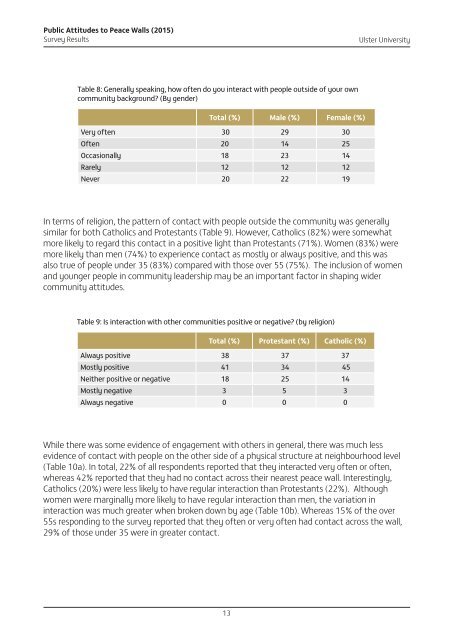Public Attitudes to Peace Walls (2015)
1RRkqqy
1RRkqqy
You also want an ePaper? Increase the reach of your titles
YUMPU automatically turns print PDFs into web optimized ePapers that Google loves.
<strong>Public</strong> <strong>Attitudes</strong> <strong>to</strong> <strong>Peace</strong> <strong>Walls</strong> (<strong>2015</strong>)<br />
Survey Results<br />
Ulster University<br />
Table 8: Generally speaking, how often do you interact with people outside of your own<br />
community background? (By gender)<br />
Total (%) Male (%) Female (%)<br />
Very often 30 29 30<br />
Often 20 14 25<br />
Occasionally 18 23 14<br />
Rarely 12 12 12<br />
Never 20 22 19<br />
In terms of religion, the pattern of contact with people outside the community was generally<br />
similar for both Catholics and Protestants (Table 9). However, Catholics (82%) were somewhat<br />
more likely <strong>to</strong> regard this contact in a positive light than Protestants (71%). Women (83%) were<br />
more likely than men (74%) <strong>to</strong> experience contact as mostly or always positive, and this was<br />
also true of people under 35 (83%) compared with those over 55 (75%). The inclusion of women<br />
and younger people in community leadership may be an important fac<strong>to</strong>r in shaping wider<br />
community attitudes.<br />
Table 9: Is interaction with other communities positive or negative? (by religion)<br />
Total (%) Protestant (%) Catholic (%)<br />
Always positive 38 37 37<br />
Mostly positive 41 34 45<br />
Neither positive or negative 18 25 14<br />
Mostly negative 3 5 3<br />
Always negative 0 0 0<br />
While there was some evidence of engagement with others in general, there was much less<br />
evidence of contact with people on the other side of a physical structure at neighbourhood level<br />
(Table 10a). In <strong>to</strong>tal, 22% of all respondents reported that they interacted very often or often,<br />
whereas 42% reported that they had no contact across their nearest peace wall. Interestingly,<br />
Catholics (20%) were less likely <strong>to</strong> have regular interaction than Protestants (22%). Although<br />
women were marginally more likely <strong>to</strong> have regular interaction than men, the variation in<br />
interaction was much greater when broken down by age (Table 10b). Whereas 15% of the over<br />
55s responding <strong>to</strong> the survey reported that they often or very often had contact across the wall,<br />
29% of those under 35 were in greater contact.<br />
13




